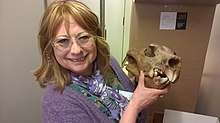Christine Janis
Christine Marie Janis is a British palaeontologist who specialises in mammals. She is currently based at the University of Bristol.[1]
Christine Marie Janis | |
|---|---|
 | |
| Alma mater | University of Cambridge 1973 Harvard University 1979 |
| Awards | George Gaylord Simpson Prize (1985) |
| Scientific career | |
| Institutions | University of Bristol current Brown University current Oregon State University University of Cambridge The Field Museum of Natural History The University of Chicago |
Background
Janis earned a bachelor's degree in Natural Sciences and Zoology from the University of Cambridge, and a PhD in Vertebrate Paleontology from Harvard University.[2] She has held positions as a researcher and lecturer at Oregon State University, Cambridge, the Field Museum of Natural History in the University of Chicago, the University of Bristol, and Brown University.
In 1985 Janis was awarded the George Gaylord Simpson Prize for Paleontology (Yale University, USA) and was elected Fellow of the Paleontological Society in 2007.
Janis attributes her interest in palaeontology to seeing Fantasia as a child.[2]. She was married to fellow palaeontologist Jack Sepkoski (1948-1999).
Scientific contributions
Janis is best known for her contributions to the study of ungulates (hoofed mammals). As well as a large scientific publication list, Janis has contributed widely to textbooks and popular articles.[3]
Her earlier publications examine mammal teeth. For example, ungulate teeth changed from low crowned teeth to high crowned hypsodont teeth, as they evolved to adapt to a grassland diet, and this is correlated with changes in their digestion and can be used in their taxonomy [4][5][6]. She created the Hipsodonty Index, broadly used in mammal paleontology.[7] Her work on the evolution of horns in ungulates won her the Simpson Prize in 1985.[8]
In the 1990s, Janis switched focus from teeth to the biomechanics of locomotion. She has produced seminal works on the relationships between the lengths of limb bones in running mammals and their locomotion.[9] Latterly Janis has worked closely with her students and close colleagues to explore locomotion in various mammal groups, including camels,[10] various carnivores,[11][12] and marsupials.[13][14]
Among Janis's publications are the co-authored textbooks Evolution of Tertiary Mammals of North America. Vol. 2: Small Mammals, Edentates, and Marine Mammals and Vertebrate Life.
Affiliations
Society of Vertebrate Paleontology (USA)
The Paleontological Society (USA)
The Palaeontological Association (UK)
GRIPS (Greater Rhode Island Paleontological Society) charter member.
Society for the Study of Mammalian Evolution (president)
Society for Integrative and Comparative Biology
National Center for Science Education
References
- Bristol, University of. "Professor Christine Janis - School of Earth Sciences". www.bris.ac.uk.
- "Janis, Christine". vivo.brown.edu.
- "Christine Marie Janis Curriculum Vitae" (PDF). Brown University. May 2012.
- Janis, C. 1976. The evolutionary strategy of the Equidae and the origins of rumen and cecal digestion. Evolution, 30(4), pp.757-774.
- Janis, C.M. and A. Lister (1985). The use of the morphology of the lower fourth premolar as a taxonomic character in the Ruminantia (Mammalia; Artiodactyla), and the systematic position of Triceromeryx. Journal of Paleontology, 59:405-410.
- Janis, C.M. (1988). An estimation of tooth volume and hypsodonty indices in ungulate mammals, and the correlation of these factors with dietary preferences. In: D.E. Russell, J.-P. Santoro and D. Sigogneau-Russell (eds.), Teeth Revisited: Proceedings of the VIIth. International Symposium on Dental Morphology, Paris 1986. Mémoirs de Musée d'Histoire naturelle, Paris (serie C), 53:367-387
- Madden, R. H. (Richard H.),. Hypsodonty in mammals : evolution, geomorphology and the role of earth surface processes. Cambridge. ISBN 978-1-316-20354-5. OCLC 897117168.CS1 maint: extra punctuation (link) CS1 maint: multiple names: authors list (link)
- Janis, C. 1982. Evolution of horns in ungulates: ecology and paleoecology. Biological Reviews, 57(2), pp.261-318
- Garland, T., Jr. and Janis, CM 1993). Does metatarsal/femur ratio predict maximal running speed in cursorial mammals? Journal of Zoology, London, 229:133-151.
- Janis, C.M., J.M. Theodor, and B. Boisvert*. 2002. Locomotor evolution in camels revisited: a quantitative analysis of pedal morphology and the acquisition of the pacing gait. Journal of Vertebrate Paleontology, 22:110-120.
- Palmqvist, P., J.A. Pérez-Claros., C.M. Janis, B. Figueirido, V.,Torregrosa, and D.R. Gröcke (2008). Biogeochemical and ecomorphological inferences on prey selection and resource partitioning among mammalian carnivores in an early Pleistocene community. Palaios, 23: 724–737.
- Panciroli, E., Janis, C., Stockdale, M. and Martín‐Serra, A., 2017. Correlates between calcaneal morphology and locomotion in extant and extinct carnivorous mammals. Journal of morphology, 278(10), pp.1333-1353.
- Bassarova, M., C.M. Janis, and M. Archer (2009). The calcaneum – on the heels of marsupial locomotion. Journal of Mammalian Evolution,16:1-23
- Figueirido, B.and C. M. Janis(2011). The predatory behaviour of the thylacine: Tasmanian tiger or marsupial wolf? Biology Letters 7:937-940.